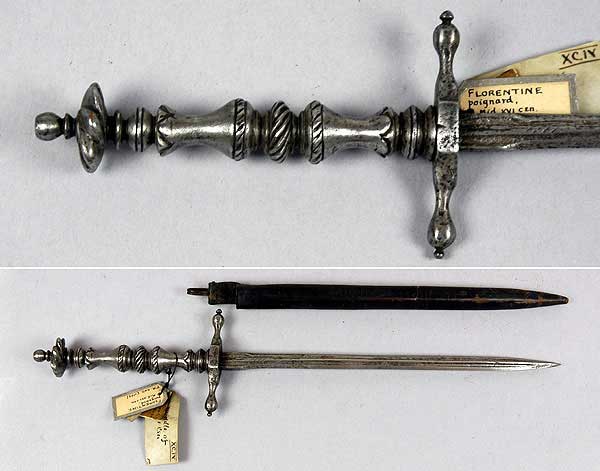File:1884.24.216.jpg
1884.24.216.jpg (600 × 471 pixels, file size: 27 KB, MIME type: image/jpeg)
This mid-16th century weapon is a type of poignard (dagger) known as a stiletto, meaning, ‘Little Steel’ in Italian. Taking their cue from this elegant but deadly weapon, ladies’ shoes with long, thin heels have also become known as stilettos.
Italian princes and dukes issued stilettos to their gunners, as the principal weapon of self-defence, should the artillery line be overrun. Gunners often had their stilettos inscribed with mathematical and geometric scales to help them calculate the correct angle for their cannons.
Form and Function This Italian knife is a fine and early example of a true stiletto or ‘little steel’, a one-piece, all-steel dagger. Stilettos were developed in late Medieval and Renaissance Italy as anti-armour knives. The slenderness of a stiletto blade focuses the force of the attack into a tiny area, which multiplies its pressure enormously. This means it could pierce plate armour or cut through chain mail rings. This tactic also had a scientific basis - it is medically well established that a small, deep cut in the right place is much more likely to kill than a large shallow one.
Many stilettos bear several narrow grooves running the length of their blades. These are often conventionally explained as channels to contain poison, and indeed this is what the entry in the Museum’s original 19th century Accession Book states. However, most blades are ‘cannellated’ or ‘fullered’ to become lighter - as there is less metal used - and stronger under impact. Fullers strengthen blades by introducing arch forms into their shape. Just as arches balance and distribute forces through a bridge, so they will perform the same function on the blade of a sword, dagger or knife.
This example exhibits a very beautiful ‘baluster’-formed hilt, turned very artfully on a lathe. This reflects the advanced nature of Renaissance Italian metalwork, as the lathe-turning of solid steel is something we might associate more with the grand engineering of the 19th and 20th centuries. These ‘baluster’ or ‘columnar’ hilts are characteristic of northern Italian stilettos of the period 1500-1550.
File history
Click on a date/time to view the file as it appeared at that time.
| Date/Time | Thumbnail | Dimensions | User | Comment | |
|---|---|---|---|---|---|
| current | 04:31, 12 November 2008 |  | 600 × 471 (27 KB) | Linden (talk | contribs) | This mid-16th century weapon is a type of poignard (dagger) known as a stiletto, meaning, ‘Little Steel’ in Italian. Taking their cue from this elegant but deadly weapon, ladies’ shoes with long, thin heels have also become known as stilettos. Ital |
- You cannot overwrite this file.
File usage
The following page uses this file: